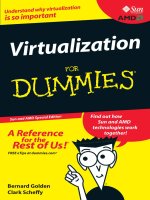Wiley RF measurements for cellular phones and wireless data systems jul 2008 ISBN 0470129484 pdf
Bạn đang xem bản rút gọn của tài liệu. Xem và tải ngay bản đầy đủ của tài liệu tại đây (14.67 MB, 525 trang )
RF MEASUREMENTS FOR
CELLULAR PHONES AND
WIRELESS DATA
SYSTEMS
ALLAN W. SCOTT
REX FROBENIUS
RF MEASUREMENTS FOR
CELLULAR PHONES AND
WIRELESS DATA
SYSTEMS
RF MEASUREMENTS FOR
CELLULAR PHONES AND
WIRELESS DATA
SYSTEMS
ALLAN W. SCOTT
REX FROBENIUS
Copyright # 2008 by John Wiley & Sons, Inc. All rights reserved
Published by John Wiley & Sons, Inc., Hoboken, New Jersey
Published simultaneously in Canada
No part of this publication may be reproduced, stored in a retrieval system, or transmitted in any form
or by any means, electronic, mechanical, photocopying, recording, scanning, or otherwise, except as
permitted under Section 107 or 108 of the 1976 United States Copyright Act, without either the prior
written permission of the Publisher, or authorization through payment of the appropriate per-copy fee to
the Copyright Clearance Center, Inc., 222 Rosewood Drive, Danvers, MA 01923, (978) 750-8400, fax
(978) 750-4470, or on the web at www.copyright.com. Requests to the Publisher for permission should
be addressed to the Permissions Department, John Wiley & Sons, Inc., 111 River Street, Hoboken, NJ
07030, (201) 748-6011, fax (201) 748-6008, or online at />Limit of Liability/Disclaimer of Warranty: While the publisher and author have used their best efforts
in preparing this book, they make no representations or warranties with respect to the accuracy or completeness of the contents of this book and specifically disclaim any implied warranties of merchantability or
fitness for a particular purpose. No warranty may be created or extended by sales representatives or written
sales materials. The advice and strategies contained herein may not be suitable for your situation. You
should consult with a professional where appropriate. Neither the publisher nor author shall be liable
for any loss of profit or any other commercial damages, including but not limited to special, incidental,
consequential, or other damages.
For general information on our other products and services or for technical support, please contact our
Customer Care Department within the United States at (800) 762-2974, outside the United States at
(317) 572-3993 or fax (317) 572-4002.
Wiley also publishes its books in a variety of electronic formats. Some content that appears in print may
not be available in electronic formats. For more information about Wiley products, visit our web site
at www.wiley.com.
Library of Congress Cataloging-in-Publication Data:
Scott, Allan W.
RF measurements for cellular phones and wireless data systems/Allan W. Scott, Rex Frobenius.
p. cm.
ISBN 978-0-470-12948-7 (cloth)
1. Radio frequency integrated circuits—Testing. 2. Wireless communication systems—Equipment
and supplies—Design and construction. 3. Cellular telephones—Equipment and supplies—Design
and construction. I. Frobenius, Rex. II. Title.
TK7874.S36 2008
621.38450 6—dc22
2008004929
Printed in the United States of America
10 9 8 7 6 5 4 3 2 1
CONTENTS
1
INTRODUCTION
1.1
1.2
1.3
1.4
1.5
1.6
1.7
1.8
1.9
1.10
1.11
1.12
1.13
1.14
1.15
1.16
1.17
1.18
1
The Market for Cellular Phones and Wireless Data Transmission
Equipment / 1
Organization of the Book / 3
Part I: RF Principles / 4
Summary of Chapter 2: Characteristics of RF Signals / 4
Summary of Chapter 3: Mismatches / 4
Summary of Chapter 4: Digital Modulation / 4
Part II: RF Measurement Equipment / 9
Summary of Chapter 5: RF Signal Generators / 9
Summary of Chapter 6: Power Meters / 10
Summary of Chapter 7: Frequency Counters / 10
Summary of Chapter 8: VNAs / 14
Summary of Chapter 9: Spectrum Analyzers / 14
Summary of Chapter 10: VSAs / 17
Summary of Chapter 11: Noise Figure Meters / 17
Summary of Chapter 12: Coaxial Cables and Connectors / 19
Summary of Chapter 13: Measurement Uncertainties
/ 19
Summary of Chapter 14: Measurement of Components Without Coaxial
Connectors / 21
Part III: Measurement of Individual RF Components / 21
v
vi
CONTENTS
1.19 Summary of Chapter 15: RF Communications
System Block Diagram / 22
1.20 Summary of Chapter 16: Signal Control Components / 22
1.21 Summary of Chapter 17: PLOs / 22
1.22 Summary of Chapter 18: Upconverters / 24
1.23 Summary of Chapter 19: Power Amplifiers / 24
1.24 Summary of Chapter 20: Antennas / 29
1.25 Summary of Chapter 21: RF Receiver Requirements / 31
1.26 Summary of Chapter 22: RF Filters / 33
1.27 Summary of Chapter 23: LNAs / 35
1.28 Summary of Chapter 24: Mixers / 36
1.29 Summary of Chapter 25: Noise Figure Measurement / 38
1.30 Summary of Chapter 26: Intermodulation Product Measurement / 38
1.31 Summary of Chapter 27: Overall Receiver / 39
1.32 Summary of Chapter 28: RFICs and SOC / 39
1.33 Part IV: Testing of Devices and Systems with Digitally
Modulated RF Signals / 41
1.34 Summary of Chapter 29: Digital Communications Signals / 42
1.35 Summary of Chapter 30: FDMA, TDMA, and CDMA Multiple Access
Techniques / 44
1.36 Summary of Chapter 31: OFDM and OFDMA / 46
1.37 Summary of Chapter 32: ACP / 48
1.38 Summary of Chapter 33: Constellation, Vector, and Eye Diagrams, and
EVM / 48
1.39 Summary of Chapter 34: CCDF / 51
1.40 Summary of Chapter 35: BER / 53
1.41 Summary of Chapter 36: Measurement of GSM
Evolution Components / 54
1.42 Annotated Bibliography / 55
PART I
2
RF AND WIRELESS PRINCIPLES
CHARACTERISTICS OF RF SIGNALS
2.1
2.2
2.3
Electric and Magnetic Fields / 60
Electromagnetic Waves / 62
Properties of RF Waves / 63
Frequency / 64
Wavelength / 64
Impedance / 67
57
59
vii
CONTENTS
Power Density / 67
Phase / 68
2.4
RF Power Expressed in dB and dBm / 69
dB Terminology / 70
dBm Terminology / 72
2.5 Using dB and dBm to Determine an RF Link Budget / 73
2.6 Alternate Names for dB and dBm / 78
2.7 Annotated Bibliography / 78
3
MISMATCHES
3.1
3.2
3.3
3.4
3.5
3.6
3.7
3.8
3.9
3.10
3.11
3.12
4
The Mismatch Problem / 79
Ways of Specifying Mismatches / 80
Conversion Between Different Ways of Expressing Mismatch / 82
S-Parameters / 85
Matching with the Smith Chart / 87
Derivation of the Smith Chart / 89
Plotting Mismatches on the Smith Chart / 94
Matching Calculations with the Smith Chart / 99
Using Parallel Matching Elements / 103
Lumped Elements in Combination / 105
Smith Chart Software / 106
Annotated Bibliography / 111
DIGITAL MODULATION
4.1
4.2
4.3
79
113
Modulation Principles / 113
Multilevel Modulation / 115
Special Phase Modulation Techniques / 118
DPSK / 118
p/4QPSK / 119
3/8p 8PSK Modulation for EDGE / 119
4.4
4.5
4.6
PART II
5
Digital Frequency Modulation / 120
Upconversion Requirements / 122
Annotated Bibliography / 122
RF MEASUREMENT EQUIPMENT
RF SIGNAL GENERATORS
5.1
What an RF Signal Generator Does / 125
123
125
viii
CONTENTS
5.2 Supported Wireless Communication Formats / 127
5.3 RF Signal Generator Displays / 127
5.4 RF Signal Generator Controls / 127
5.5 Modulation Architectures / 129
5.6 Phase Noise of the RF Signal Generator / 130
5.7 Annotated Bibliography / 130
6
RF POWER METERS
131
RF Power Meter Basics / 131
Power Meter Sensors / 133
A Schottky Diode for Power Measurements in Cellular Phone
Systems / 134
6.4 The Power Meter Unit / 135
6.5 Power Meter Controls / 138
6.6 Annotated Bibliography / 138
6.1
6.2
6.3
7
FREQUENCY COUNTERS
7.1
7.2
8
Frequency Counter Operation / 139
Annotated Bibliography / 141
VNAs
8.1 What a VNA Does / 143
8.2 What a VNA Can Measure / 143
8.3 VNA Controls / 144
Dislay Control / 144
Channel Setup / 145
Trace Setup / 145
Entry Control / 147
8.4
8.5
8.6
8.7
8.8
VNA Display Notations / 147
Error Correction / 147
Example of VNA Measurements on an RF Part / 152
Swept Measurements on the VNA as a Function of Power / 154
Example Measurement Procedure Using the VNA / 157
Objective / 157
Measurements Being Demonstrated / 158
DUT Specifications / 161
Significance to Wireless System Performance / 161
Generic Procedure / 161
8.9
139
Annotated Bibliography / 165
143
CONTENTS
9
SPECTRUM ANALYZERS
9.1
9.2
9.3
9.4
ix
167
Spectrum Analyzer Principles / 167
What a Spectrum Analyzer Can Measure / 168
Spectrum Analyzer Block Diagram / 170
Spectrum Analyzer Controls / 171
Center Frequency and Span / 171
Reference Level and Attenuation / 172
Resolution Bandwidth / 173
Video Bandwidth / 173
Markers / 175
9.5
9.6
9.7
Power Suite Measurements / 175
Basic Modulation Formats / 175
Example Spectrum Analyzer Operation and FM Spectrum
Measurement / 178
Objective / 178
FM Theory / 178
Measurements Being Demonstrated / 178
Generic Procedure / 178
9.8
Annotated Bibliography / 180
10 VSAs
10.1
10.2
10.3
10.4
183
What a VSA Does / 183
VSA Equipment / 183
What the VSA Can Measure / 185
Annotated Bibliography / 191
11 NOISE FIGURE METERS
11.1
11.2
11.3
Noise Figure Meter Setup / 193
Noise Figure Principles / 193
Annotated Bibliography / 197
12 COAXIAL CABLES AND CONNECTORS
12.1
12.2
12.3
12.4
12.5
193
Coaxial Connectors / 199
Cables and Connectors Best Practices / 200
Popular Coaxial Cable Connectors / 200
Coaxial Cables / 202
Annotated Bibliography / 202
199
x
CONTENTS
13 RF MEASUREMENT UNCERTAINTIES
13.1
13.2
203
Mismatch Uncertainties / 204
RF Power Meter Measurement Uncertainties / 205
Mismatch Uncertainties / 205
Calibration Factor Uncertainty / 207
Magnification and Offset / 207
13.3
13.4
Uncertainty of VNA Measurement of Absolute Power / 207
Uncertainty of Spectrum Analyzer Measurements / 210
Frequency Measurement Uncertainty / 210
Power Measurement Uncertainty / 210
Examples of Measurement Uncertainty of PSA 4440E Spectrum
Analyzer Under Different Measurement Conditions / 211
13.5
13.6
13.7
Measurement Uncertainties of Ratioed Measurements with a
VNA / 211
Noise Figure Measurement Uncertainty / 215
Annotated Bibliography / 216
14 COMPONENTS THAT DO NOT HAVE
COAXIAL CONNECTORS
14.1
14.2
14.3
14.4
14.5
PART III
Using SOLT Calibration Standards Fabricated in Microstrip / 220
TRL Standards in Microstrip / 222
De-Embedding / 222
Including the Fixture Effects as Part of the VNA Calibration / 223
Annotated Bibliography / 223
MEASUREMENT OF INDIVIDUAL RF
COMPONENTS
15 RF COMMUNICATIONS SYSTEM BLOCK DIAGRAM
15.1
15.2
225
227
RF Communications System Components / 227
Annotated Bibliography / 232
16 SIGNAL CONTROL COMPONENTS
16.1
16.2
16.3
16.4
219
RF Semiconductors / 233
Electronically Controlled Attenuators and Switches / 236
Measurements of PIN Diode Attenuators and Switches / 240
Annotated Bibliography / 240
233
xi
CONTENTS
17 PLOs
241
17.1 Characteristics and Operation of a PLO / 241
17.2 Phase Noise and its Significance in a Digital RF
Communications System / 246
17.3 Characteristics of PLOs that Need to be Measured / 248
Frequency / 248
Tuning Sensitivity / 249
Power / 249
Phase Noise / 249
17.4 Example Procedure for Phase Noise Measurements of PLOs / 252
Measurements Being Described / 252
Specifications of PLO / 252
Significance to Wireless System Performance / 252
Generic Procedure / 252
17.5 Annotated Bibliography / 254
18 UPCONVERTERS
255
18.1 How an Upconverter Works / 255
18.2 Mathematical Theory of Upconverter and
Mixer Action / 257
18.3 Measurement of Upconverter Performance / 258
18.4 Generic Procedure for Upconverter Measurement / 261
18.5 Annotated Bibliography / 262
19 POWER AMPLIFIERS
263
19.1 RF Transistors / 263
19.2 Semiconductor Materials for RF Transistors / 264
19.3 Transistor Fabrication Processes / 265
MESFETs / 265
19.4
19.5
19.6
19.7
Bipolar Transistor / 268
HEMTs and HBTs / 270
LDMOS / 271
Modulation Distortion Caused by Power Amplifier
Nonlinearity / 272
Measurements to be Performed on RF Power Amplifiers / 278
Measurements of Amplifier Output Characteristics Versus Frequency
and Input Power / 278
Harmonic Power Measurements / 283
xii
CONTENTS
19.8
Example Power Amp Measurements on the VNA / 284
19.9
Objective / 284
Measurements Being Demonstrated / 285
Specifications of Power Amplifier / 285
Generic Procedure / 285
Annotated Bibliography / 287
20 ANTENNAS
20.1
Antenna Functions / 289
20.2
Gain / 289
Pattern / 291
Gain / 292
Side Lobes / 292
Polarization / 292
Impedance Match / 293
Antenna Area / 293
Types of Antennas / 293
20.3
20.4
20.5
Half-Wave Dipole Antenna / 293
Patch Antenna / 295
Colinear Dipole Array / 296
Parabolic Dish Antennas / 297
Patch Antenna Array / 297
Measurement of Antennas / 299
Duplexers / 301
Annotated Bibliography / 302
21 RF RECEIVER REQUIREMENTS
21.1
303
Annotated Bibliography / 305
22 RF FILTERS
22.1
22.2
22.3
289
RF Filter Characteristics / 307
RF Filter Design / 308
Types of Filters / 309
Microstrip Filter / 309
Ceramic Block Filter / 309
Surface Acoustic Wave (SAW) Filters / 310
Film Bulk Acoustic Resonator (FBAR) Filters / 311
Base Station Filters / 312
307
CONTENTS
xiii
22.4 Measurement of RF Filters / 313
22.5 Group Delay and its Measurement / 314
22.6 Example Filter Measurement / 318
22.7
Objective / 318
Measurements Being Demonstrated / 318
Specifications of DUT / 318
Generic Procedure / 319
Annotated Bibliography / 319
23 LNAs
321
23.1 Thermal Noise / 322
23.2 Noise Figure Principles / 322
Noise Figure of Passive Components / 323
Cascaded Noise Figure / 324
Mismatching of the Transistor Input to
Reduce Noise Figure / 325
23.3 Intermodulation Products / 328
23.4 S-Parameters and How they are Used / 331
23.5 Example LNA Measurement on the VNA / 334
Objective / 334
Measurements Being Demonstrated / 335
Specifications of LNA / 335
Generic Procedure / 335
23.6 Annotated Bibliography / 344
24 MIXERS
24.1
24.2
24.3
24.4
24.5
24.6
Basic Mixer Performance / 345
Selection of Individual Voice and Data Channels / 349
The Removal of Image Noise / 350
ZIF Mixer / 351
Mixer Measurements / 353
Annotated Bibliography / 355
25 NOISE FIGURE MEASUREMENT
25.1
345
Noise Figure Measurement Setup
and Procedure / 357
25.2 Measurement of the Noise Figure and Gain of LNAs, Filters, and
Mixers / 358
357
xiv
CONTENTS
25.3
25.4
25.5
Approximate Measurements of Noise Figure Without the NF
Hardware and Software / 363
Measurement of Noise Figure Contours on the
Smith Chart / 364
Annotated Bibliography / 364
26 INTERMODULATION PRODUCT MEASUREMENT
26.1
26.2
26.3
26.4
26.5
Intermodulation Products / 367
Third-Order Intercept Point / 369
Calculation of Maximum Input Power / 370
Cautions When Measuring Distortion Products / 371
Example Measurement for Intermodulation Products / 371
26.6
Objective / 371
Measurements Being Demonstrated / 372
Generic Procedure / 372
Annotated Bibliography / 373
367
27 OVERALL RECEIVER PERFORMANCE
27.1
27.2
27.3
27.4
27.5
27.6
Overall Performance of a Typical RF Receiver / 376
Formulas for Combining Gain, Noise Figure, and OIP3
of the Receiver Components / 379
Software for Calculation of Overall Receiver Performance / 379
Calculation of Overall Receiver Performance as a Function of Part
Temperature / 383
Switching the LNA Into and Out of the Overall Receiver / 384
Annotated Bibliography / 385
28 RFICs
28.1
28.2
28.3
PART IV
387
Wireless LAN / 388
Four Band GSM, GPRS, EDGE Handset / 389
Annotated Bibliography / 392
TESTING OF DEVICES WITH DIGITALLY
MODULATED SIGNALS
29 WIRELESS COMMUNICATION SYSTEMS
29.1
29.2
375
Block Diagram of the Complete Wireless Communication
System / 396
Analog Voice and Video Signals / 398
393
395
CONTENTS
xv
29.3 The Digitizing of Analog Signals / 400
29.4 Data Signals / 403
29.5 Compression of Digital Voice and Data Signals / 404
29.6
29.7
29.8
29.9
Compression of Voice Signals / 404
Compression of Video Signals / 406
Error Correction / 407
Typical Bit Rates of
Communications Systems / 409
Packet Switching / 410
Annotated Bibliography / 411
30 MULTIPLE ACCESS TECHNIQUES: FDMA,
TDMA, AND CDMA
413
30.1 Frequency Division Multiple Access (FDMA) / 413
30.2 Time Division Multiple Access (TDMA) / 416
30.3 Code Division Multiple Access (CDMA) / 418
30.4 3G Cell Phones / 424
30.5 High Data Rate Systems for Cell Phones / 425
Cdma2000 Systems / 425
HSDPA High Data Rate Systems / 426
30.6 Measurement of the Distortion of Digitally Modulated Signals by
RF Components / 429
30.7 Annotated Bibliography / 429
31 OFDM, OFDMA, AND WiMAX
31.1
31.2
31.3
31.4
431
802.11 Specifications / 431
OFDM Multiple Access Principles / 433
WiMAX / 435
Annotated Bibliography / 437
32 ACP
32.1 ACP / 439
32.2 Measuring ACP / 440
32.3 ACP for North American Digital Cellular (NADC) Versus
GSM Modulation Formats / 440
32.4 Backoff / 441
32.5 ACP Measurement Results for NADC and GSM / 441
32.6 Zero Span / 443
32.7 Annotated Bibliography / 444
439
xvi
CONTENTS
33 CONSTELLATION, VECTOR, AND
EYE DIAGRAM AND EVM
33.1
33.2
Power Amplifier Backoff / 446
Constellation, Vector, and Eye Diagrams / 447
33.3
Constellation Diagram / 447
Vector Diagram / 447
Eye Diagram / 447
EVM / 451
33.4
33.5
33.6
EVM Troubleshooting / 451
EVM Versus Time / 451
EVM Spectrum / 451
IQ Modulator Impairments / 454
Measurements of Constellation, Vector, and Eye Diagrams
and EVM on an RF Power Amplifier and on an IF Filter / 454
EVM Trouble Shooting Tree / 463
Annotated Bibliography / 463
34 CCDF
34.1
34.2
34.3
34.4
34.5
34.6
475
BER (Bit Error Rate) Testing / 475
Annotated Bibliography / 477
36 MEASUREMENT OF GSM EVOLUTION COMPONENTS
36.1
36.2
36.3
465
CCDF Curves / 466
Derivation of CCDF Curves / 467
Comparison of Vector Diagrams and CCDF / 467
The Effect of the Number of Active Spread Spectrum Codes / 470
CCDF in Component Design / 470
Annotated Bibliography / 473
35 BER
35.1
35.2
445
479
Measurement of EDGE Signal Distortion / 481
Measurement of WCDMA and HSDPA Distortions / 482
Annotated Bibliography / 489
TERMINOLOGY
491
INDEX
497
FOREWORD
In the late 1960s as part of a technical seminar team, I traveled with HP’s firstgeneration Automatic Network Analyzer (ANA), discussing and demonstrating
new measurements and s-parameter design techniques. One of our stops was at a
U.S. East Coast based defense organization, where a large group gathered to hear
our talk. At the conclusion, a man with a skeptical expression on his face indicated
that he had two questions. In a somewhat hostile manner he asked, “Are you
telling me that with this new equipment I can reliably characterize active devices at
microwave frequencies?” We assured him that for small-signal applications it was
true. Then he went on, “If I turn off the equipment today, and repeat my measurement
tomorrow, will I get the same data?” Again, we replied that after proper calibration, he
will have the same results. Shaking his head in disbelief he said, “I cannot believe
such b.s.,” and stormed out of the lecture hall.
It is hard to understand such a reaction today. However, until the introduction of
the network analyzer, obtaining reliable and repeatable y-parameter component
characterization with its predecessor, the General Radio RF Bridge, was not possible.
Without accurate data or component models, microwave circuit design was more of
an art than science.
Even after the spectrum analyzer, network analyzer, and modern power meters
became available, relatively simple gain, impedance, power, harmonic and twotone intermodulation measurements represented a large percentage of microwave
testing. This is in sharp contrast to what test engineers and technicians face today,
working on products using a wide range of mixed-mode signal processing. In
addition, they have to understand and measure parameters, Bit Error Rate (BER),
constellation and eye diagrams, Adjacent Channel Power (ACP), just to mention a
xvii
xviii
FOREWORD
few. They also have to be familiar with various digital modulation systems, including
analog concepts. Last but not least, in the globally competitive marketplace, measurements must be performed rapidly and inexpensively.
The authors of this book based the contents on their extensive experience teaching
continuing education courses to practicing professionals of the RF and microwave
industries. Their course material is fine-tuned with the feedback provided by
course participants and constantly updated to keep up with changes in technology.
Measurements described in the book range from basic to advanced types, in addition
to reviewing the necessary technical background of cellular and wireless communication systems. I am not aware of any other textbook having such a wealth of information, written in a simple, easily understandable style, without constant use of
complex mathematics. Learning the techniques described in the book will elevate
the value of anyone working in the field.
LES BESSER
Besser Associates
Mountain View, CA
ACKNOWLEDGMENTS
We would like to thank all the organizations and people who helped make this book
possible.
The idea began when the Test and Measurement Division of Hewlett-Packard
offered Besser Associates the loan of a suite of RF test equipment for demonstration
in their RF classes. Besser Associates is the worldwide leader in RT training, having
trained over 40,000 engineers, technicians and managers in RF topics. We serve as
instructors for Besser Associates. So beginning in 1998, we began a demonstration
class on RF Measurements using the HP equipment.
When HP split off their Test and Measurement Equipment division to become
Agilent Technologies, Agilent continued the loan of RF test equipment ot Besser.
As the cellular phone and wireless data industry grew and became more technically
complicated, so did the test equipment. We are grateful to Susan Owen of Agilent for
continuing to support this ongoing relationship, which always allowed us access to
the latest models of their equipment. We would also like to thank Ben Zarlingo,
who offered extensive support and insight into the operation of the Vector
Signal Analyzer.
Many other companies, like Anritsu, Rhode and Schwartz, Aeroflex, and Keithley,
to name a few, also make excellent test equipment. Often they demonstrated their test
equipment in our course. Along these lines we enjoyed a great deal of support from
David Vondran of Anritsu corporation, who provided detailed background on the
Scorpion Network Analyzer and noise figure measurements. We did not try to
make comparisons between test equipments, but continued to conduct a course
using the Agilent equipment, because of their generosity in always loaning us the
xix
xx
ACKNOWLEDGMENTS
latest and best they had. This kept us busy learning how to operate their continually
evolving equipment, as the cell phone industry itself evolved.
The Besser RF Measurements course has continued to grow in popularity. Initially
we taught the five-day course a few times a year, then several times a year. Last year
(2007) we taught it 7 times. About a year ago, we decided to write this book, based on
the RF Measurements course.
We would also like to thank everyone at Besser Associates, Founder Dr. Les
Besser, President Jeff Lange, VP of Sales Annie Wong, and all the administrative
staff and instructors who helped and encouraged us to write this book. We would
also like to thank Allen Podell for providing numerous technical insights as well
as practical tips on keeping our fragile lab components in good repair.
Finally, we would like to thank all the engineers, technicians, and managers who
have taken our RF measurements course and made valuable suggestions on how to
make it better.
We hope you will enjoy our book and find it useful. We hope that it will improve
your understanding of RF measurements by at least 7 dB.
AL SCOTT
REX FROBENIUS
CHAPTER 1
INTRODUCTION
1.1 THE MARKET FOR CELLULAR PHONES AND
WIRELESS DATA TRANSMISSION EQUIPMENT
The market for cellular phones and wireless data transmission equipment has changed
dramatically since the late 1970s when cellular phones were first introduced and the
late 1980s when wireless data equipment became available. As would be expected,
during this time RF test requirements and RF test equipment has changed dramatically.
The original cellular phones, which were introduced in North America in the 1970s,
were FM analog voice phones with a limited data capability of less than 10 kbps. These
analog phones are now called first generation (1G). Cellular phones were digitized in
the early 1980s to provide for an increased number of user channels in a given RF frequency band. These digital phones are now called second generation (2G).
During the 1990s the use of 2G cell phones increased dramatically throughout the
world, growing to over 2 billion handsets worldwide by 2005. Eighty percent of 2G
phones are Global System for Mobile Communications (GSM), using digital FM
modulation. The reasons for the expansive growth of GSM phones was (1) the
excellent voice quality of the digital signal, which could accurately digitize any
language, and (2) an effective worldwide management and billing system for all of
its customers.
During the growth of GSM phone capacity worldwide, the North American cellular industry was divided between proponents of using a Time Division Multiple
Access (TDMA) system similar to GSM, but carefully designed to be backward
RF Measurements for Cellular Phones and Wireless Data Systems. By A. W. Scott and R. Frobenius
Copyright # 2008 John Wiley & Sons, Inc.
1
2
INTRODUCTION
compatible with the RF part of the original analog system, and a new Code Division
Multiple Access (CDMA) concept advocated by Qualcomm, which provided greater
user capacity in a given RF bandwidth. After extensive field trials conducted throughout the United States in the late 1980s, the CDMA system demonstrated an approximate doubling of voice capacity compared to TDMA.
As digital voice cell phone usage grew in the 1980s, equipment manufacturers
began the development of third generation (3G) phones that, in addition to providing
high-quality wireless voice service, could also provide a wide range of data related
services including the following:
†
†
†
†
†
†
Data rate transfer exceeding 1 Mbps at any location within the cell where voice
phones worked
Wireless connected photographic cameras
Wireless connected video cameras
GPS information
Windows operating system with Word, Excel, and PowerPoint
Internet access
In order to accomplish this high data rate capacity, the greater bit rate transfer capability of CDMA systems is required. It is predicted that all cellular phone systems will
be converted to CDMA by 2012.
The 20% of system operators who had originally opted for CDMA voice phones
are already providing data transfer capability up to 1 Mbps, even though voice service
still accounted for 90% of their business in 2005.
The GSM service providers, who provide 80% of worldwide cellular voice
service, face an economic problem because of the vast amount of installed GSM
base station equipment. However, the GSM community now has a worldwide evolution plan to grow from the limited 100 kbps data capability of GSM phones to a data
capability of several gigabits per second using Wideband Code Division Multiple
Access (WCDMA)/High-Speed Downlink Packet Access (HSDPA). However, the
implementation of this high data rate equipment by the GSM community will lag
that of the current CDMA carriers by about 3 years.
The importance of these facts is that the measurement equipment needs for cellular
phone equipment are stabilized for the next 5 years, until fourth generation (4G)
phones replace the 3G phones.
In a similar way, the requirements for short-range, high data rate equipment
like Wi-Fi (802.11a, b, g, and n) are stabilized. These systems achieve data rates
up to 200 Mbps because their ranges are short. Consequently, the received power
is high and complex modulation schemes like 64-quadrature amplitude modulation
(64QAM), which transmits 6 digital bits in every Hertz of bandwidth, can be used.
A significant change in RF test equipment occurred in the early 2000s in order to
meet the needs of testing the evolving cell phone and wireless local area network
(LAN) equipment. Extensive digital processing was added to conventional RF
1.2
ORGANIZATION OF THE BOOK
3
signal generators, vector network analyzers (VNAs), and spectrum analyzers to
improve their measurement uncertainty and increase their capability.
For example, many of the newest VNAs now use a Windows operating
system instead of a proprietary operating system. This change gives increased
capacity for data processing and allows measurements to be easily transferred to
laptops or other computers for further analysis and archiving. Electronic calibration
of the VNAs is now available to reduce the uncertainty of their measurements
that is due to handling damage of the calibration standards and operator
error. Measurement of absolute power in decibels relative to 1 mW (dBm) in a
VNA is about +1 dBm. Provision is now available to calibrate the VNA
with a power meter and achieve power measurements within an uncertainty of
only +0.2 dBm.
Hardware and software options can now be added to the latest generation of spectrum analyzers to permit them to make the specialized signal analysis measurements
required for cell phone and wireless LAN. These upgrades to the spectrum analyzers
include the following:
†
†
†
†
Measurement of phase noise and noise figure
Measurement of the spectral regrowth of digitally modulated RF carriers
Ability to function as a vector signal analyzer (VSA)
Measurement of the key specifications for any cell phone or wireless LAN
system
The life cycle of RF measurement equipment (with hardware and software
upgrades) is about 15 years, so the latest versions of RF measurement equipment
will cover RF measurement needs throughout the lifetime of the current cell phone
and wireless LAN evolutions.
1.2
ORGANIZATION OF THE BOOK
RF Measurements for Cellular Phone and Wireless Data Equipment is organized as
follows:
Part I (Chapters 2 – 4) provides a review of basic RF principles. Many of the users
of this book already have knowledge of basic RF terminology, but many do not. For
those users who do not, Part I will provide this knowledge and should be studied first.
For those users who have this knowledge already, Part I will provide a good review.
Part II (Chapters 5 – 14) describes RF measurement equipment, including signal
generators, power meters, frequency meters, VNAs, spectrum analyzers, VSAs,
and other equipment.
Part III (Chapters 15 – 28) describes the RF devices that are used in cellular phones
and wireless data transmission equipment: how they work, what their critical performance parameters are, how they are tested, and what typical test results are.









